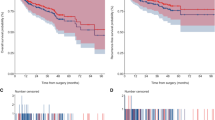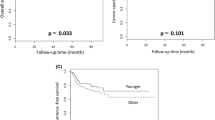Abstract
Octogenarians undergoing cystectomy experience higher morbidity and mortality compared to younger patients. Though the non-inferiority of robot-assisted radical cystectomy (RARC) compared to open radical cystectomy (ORC) has been established in a generalized population, the benefits of the robotic approach have not been well studied in an aged population. The National Cancer Database (NCDB) was queried for all patients who underwent cystectomy for bladder cancer from 2010 to 2016. Of these, 2527 were performed in patients age 80 or older; 1988 and 539 underwent ORC and RARC, respectively. On Cox regression analysis, RARC was associated with significantly reduced odds for both 30- and 90-day mortality (HR 0.404, p = 0.004; HR 0.694, p = 0.031, respectively), though the association with overall mortality was not significant (HR 0.877, p = 0.061). The robotic group had a significantly shorter length of stay (LOS) compared to open surgery (10.3 days ORC vs. 9.3 days RARC, p = 0.028). The proportion of cases performed robotically increased over the study period from 12.2% in 2010 to 28.4% in 2016 (p = 0.009, R2 = 0.774). The study is limited by a retrospective design and a section bias, which was not completely control for in the analysis. In conclusion, RARC provides improved perioperative outcomes in aged patients compared to ORC and a trend toward greater utilization of this technique was observed.

Similar content being viewed by others
Data Availability
Data is available for assessment and any queries.
References
National Comprehensive Cancer Network. Bladder cancer (version 6.2021). 2021]; Available from: https://www.nccn.org/professionals/physician_gls/pdf/bladder.pdf. Accessed 31 Jan 2021
Bream MJ et al (2017) Increased use of cystectomy in patients 75 and older: a contemporary analysis of survival and perioperative outcomes from the national cancer database. Urology 100:72–78
Roghmann F et al (2014) Radical cystectomy in the elderly: national trends and disparities in perioperative outcomes and quality of care. Urol Int 92(1):27–34
Hollenbeck BK et al (2004) Aggressive treatment for bladder cancer is associated with improved overall survival among patients 80 years old or older. Urology 64(2):292–297
Menon M et al (2003) Nerve-sparing robot-assisted radical cystoprostatectomy and urinary diversion. BJU Int 92(3):232–236
Shabsigh A et al (2009) Defining early morbidity of radical cystectomy for patients with bladder cancer using a standardized reporting methodology. Eur Urol 55(1):164–174
Yu HY et al (2012) Comparative analysis of outcomes and costs following open radical cystectomy versus robot-assisted laparoscopic radical cystectomy: results from the US nationwide inpatient sample. Eur Urol 61(6):1239–1244
Johar RS et al (2013) Complications after robot-assisted radical cystectomy: results from the international robotic cystectomy consortium. Eur Urol 64(1):52–57
Atmaca AF et al (2015) Open versus robotic radical cystectomy with intracorporeal Studer diversion. JSLS 19(1):e20140 0193
Tan WS et al (2016) Analysis of open and intracorporeal robotic assisted radical cystectomy shows no significant difference in recurrence patterns and oncological outcomes. Urol Oncol 34(6):257 e1–9
Flamiatos JF et al (2019) Open versus robot-assisted radical cystectomy: 30-day perioperative comparison and predictors for cost-to-patient, complication, and readmission. J Robot Surg 13(1):129–140
Modi PK et al (2019) Real-world impact of minimally invasive versus open radical cystectomy on perioperative outcomes and spending. Urology 125:86–91
Miguel CM et al (2020) Pathologic measures of quality compare favorably in patients undergoing robot-assisted radical cystectomy to open cystectomy cohorts: a national cancer database analysis. J Robot Surg 14(4):609–614
Rai BP et al (2019) Robotic versus open radical cystectomy for bladder cancer in adults. Cochrane Database Syst Rev 4:CD011903
Bilimoria KY et al (2008) The national cancer data base: a powerful initiative to improve cancer care in the United States. Ann Surg Oncol 15(3):683–690
Nix J et al (2010) Prospective randomized controlled trial of robotic versus open radical cystectomy for bladder cancer: perioperative and pathologic results. Eur Urol 57(2):196–201
Parekh DJ et al (2013) Perioperative outcomes and oncologic efficacy from a pilot prospective randomized clinical trial of open versus robotic assisted radical cystectomy. J Urol 189(2):474–479
Khan MS et al (2016) A single-centre early phase randomised controlled three-arm trial of open, robotic, and laparoscopic radical cystectomy (CORAL). Eur Urol 69(4):613–621
Parekh DJ et al (2018) Robot-assisted radical cystectomy versus open radical cystectomy in patients with bladder cancer (RAZOR): an open-label, randomised, phase 3, non-inferiority trial. Lancet 391(10139):2525–2536
Bochner BH et al (2018) Randomized trial comparing open radical cystectomy and robot-assisted laparoscopic radical cystectomy: oncologic outcomes. Eur Urol 74(4):465–471
Grossman HB et al (2003) Neoadjuvant chemotherapy plus cystectomy compared with cystectomy alone for locally advanced bladder cancer. N Engl J Med 349(9):859–866
Advanced Bladder Cancer Meta-analysis C (2003) Neoadjuvant chemotherapy in invasive bladder cancer: a systematic review and meta-analysis. Lancet 361(9373):1927–34
Elsayed AS et al (2020) Perioperative and oncological outcomes of robot-assisted radical cystectomy in octogenarians. J Geriatr Oncol 11(4):727–730
Yu A et al (2021) Robotic-assisted radical cystectomy is associated with lower perioperative mortality in octogenarians. Urol Oncol Apr;40(4):163
Bochner BH et al (2015) Comparing open radical cystectomy and robot-assisted laparoscopic radical cystectomy: a randomized clinical trial. Eur Urol 67(6):1042–1050
Hu JC et al (2016) Perioperative outcomes, health care costs, and survival after robotic-assisted versus open radical cystectomy: a national comparative effectiveness study. Eur Urol 70(1):195–202
Gore JL et al (2010) Use of radical cystectomy for patients with invasive bladder cancer. J Natl Cancer Inst 102(11):802–811
Smith AB et al (2014) Muscle-invasive bladder cancer: evaluating treatment and survival in the national cancer data base. BJU Int 114(5):719–726
Funding
The authors declare that no funds, grants, or other support were received during the preparation of this manuscript.
Author information
Authors and Affiliations
Contributions
All authors contributed to the study conception and design. All authors read and approved the final manuscript. FD, ZH, and JR were involved in the conceptualization of this projection. ZH was responsible for the data acquisition and analysis. CR wrote the original manuscript and created the figures for publication. All authors were involved in the editing, review, and finalization of the manuscript
Corresponding author
Ethics declarations
Conflict of interest
The authors have no relevant financial or non-financial interests to disclose.
Additional information
Publisher's Note
Springer Nature remains neutral with regard to jurisdictional claims in published maps and institutional affiliations.
Supplementary Information
Below is the link to the electronic supplementary material.
Rights and permissions
Springer Nature or its licensor (e.g. a society or other partner) holds exclusive rights to this article under a publishing agreement with the author(s) or other rightsholder(s); author self-archiving of the accepted manuscript version of this article is solely governed by the terms of such publishing agreement and applicable law.
About this article
Cite this article
Ray, C.H., Davaro, F., Hamilton, Z.A. et al. Perioperative outcomes of open versus robot-assisted radical cystectomy in octogenarians: a population based analysis. J Robotic Surg 17, 1629–1635 (2023). https://doi.org/10.1007/s11701-023-01568-0
Received:
Accepted:
Published:
Issue Date:
DOI: https://doi.org/10.1007/s11701-023-01568-0




